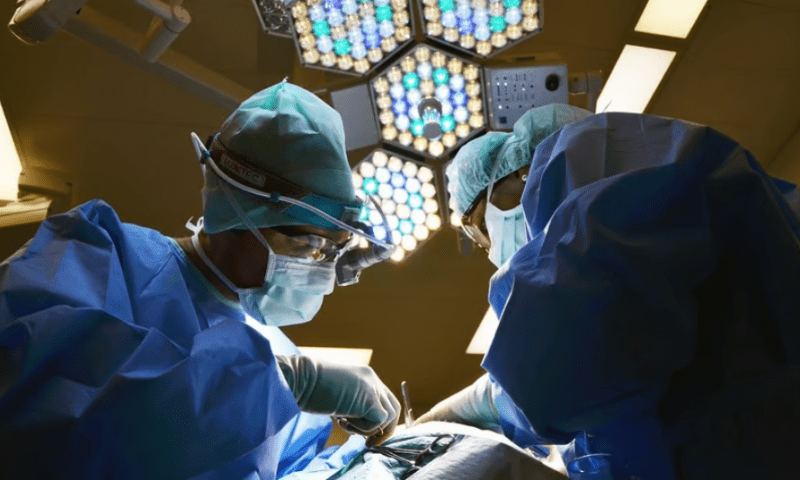When it comes to solid tumors, recurrence is a matter of margins. Surgically removing a tumor can cure a patient, but if there are any cancerous cells left around the edges of where it was taken out—the margins—it’s likely to return. Cleaning up all the residual cells is quite a challenge for surgeons, especially because it’s often hard to tell where the tumor stops and healthy tissue begins.
But a new therapy by researchers at the University of Pennsylvania might be able to help. In a paper published on Jan. 11 in Science Advances, the researchers described how they added CAR-T cells to a gel designed to prevent bleeding after surgery. When they applied the gel to the surgical wounds of 20 mice right after they had hard-to-treat tumors resected, it prevented recurrence in 19 of them without interfering with healing. Now, the therapy is on its way to being tested in humans.
“CAR-T cells have potent effects to clear residual tumor after incomplete resection in a variety of preclinical models,” Carl June, M.D., senior author and director of the Center for Cellular Immunotherapies at Penn’s Perelman School of Medicine, told Fierce Biotech Research in an email.
June’s lab built its work on an earlier study conducted by researchers at the University of North Carolina (UNC) in mouse models of glioblastoma. The researchers had filled the wounds left after the tumors were surgically resected with a porous gel called fibrin, which is derived from a protein produced by the human liver. They then added CAR-T cells to the gel, hoping they would scavenge for tumor cells that had been left behind. In that study, nine of the 14 mice were tumor-free 94 days after the surgery compared to only two of the 10 mice that received CAR-T cells alone.
Unlike the researchers in the UNC study, the Penn scientists didn’t make their own gel. Instead, they turned to an out-of-the-box solution: Tisseel. The fibrin sealant made by Baxter helps surgeons control bleeding in hard-to-reach areas. When mixing it, they adjusted the concentrations of its different components so the CAR-T cells wouldn’t migrate too far from the area while still trafficking out to tissue around the tumor.
Given that a study on using the gel in glioblastoma had already been done, June’s lab decided to test the gel in models of triple-negative breast cancer and pancreatic ductal carcinoma, the most common type of pancreatic cancer. Both tumor types are difficult to cure. Pancreatic tumors regrow in 25% of patients who have them removed, and cancer recurrence is common in breast cancer patients who have surgery that doesn’t remove all of the breast.
The researchers engineered their CAR-T cells to target mesothelin, a protein that appears on the surface of cells in the two tumor types as well as other types of adenocarcinoma. Mesothelin CAR-T cells are frequently used in CAR-T therapy in human patients, so the researchers already had data on dosing and safety, according to June.
For the surgery, the researchers split the mice up into groups according to the size and type of their cancer. They then surgically removed roughly 75% of each mouse’s tumor, leaving the other 25% behind. The scientists made sure the remaining tumor was attached to the subject’s skin and retained some blood vessels, adding hurdles the treatment would have to overcome.
As soon as the tumors were removed, the scientists covered the mice’s surgical wounds with the gel containing CAR-T cells or the CAR-T cells alone and left some mice with surgery alone. At the end of the 90-day observation period, nearly all the mice that received the CAR-T gel treatment were still alive, compared with just 25% of the ones that received CAR-T cells alone and none that only surgery.
The CAR-T cell gel didn’t just work—it did so without causing significant side effects. The researchers were concerned that the inflammation caused by the CAR-T cells combined with tissue damage would lead to an unhealing wound, especially since the mechanism by which CAR-T cells work isn’t completely understood. But the wounds healed without problems, the study found.
On top of that, except for a brief period of weight loss that resolved on its own during the study period, the mice didn’t experience systemic side effects like those seen in patients who receive CAR-T cell therapy via IV. Though this could come down to the model—human CAR-T cells may persist for a shorter time in mice, reducing the likelihood of side effects—analyses of cell migration suggested it had more to do with the delivery method.“Our results suggest that local delivery of CAR-T cells would be expected to reduce the risk of such toxicities, as local CAR-T cells did not efficiently leave the surgical site,” the scientists wrote in their paper.
Now that there’s evidence that the gel works against residual cancer cells, the researchers are moving forward to test it in humans. A clinical trial in patients with locally advanced breast cancer is in the works, according to June.

